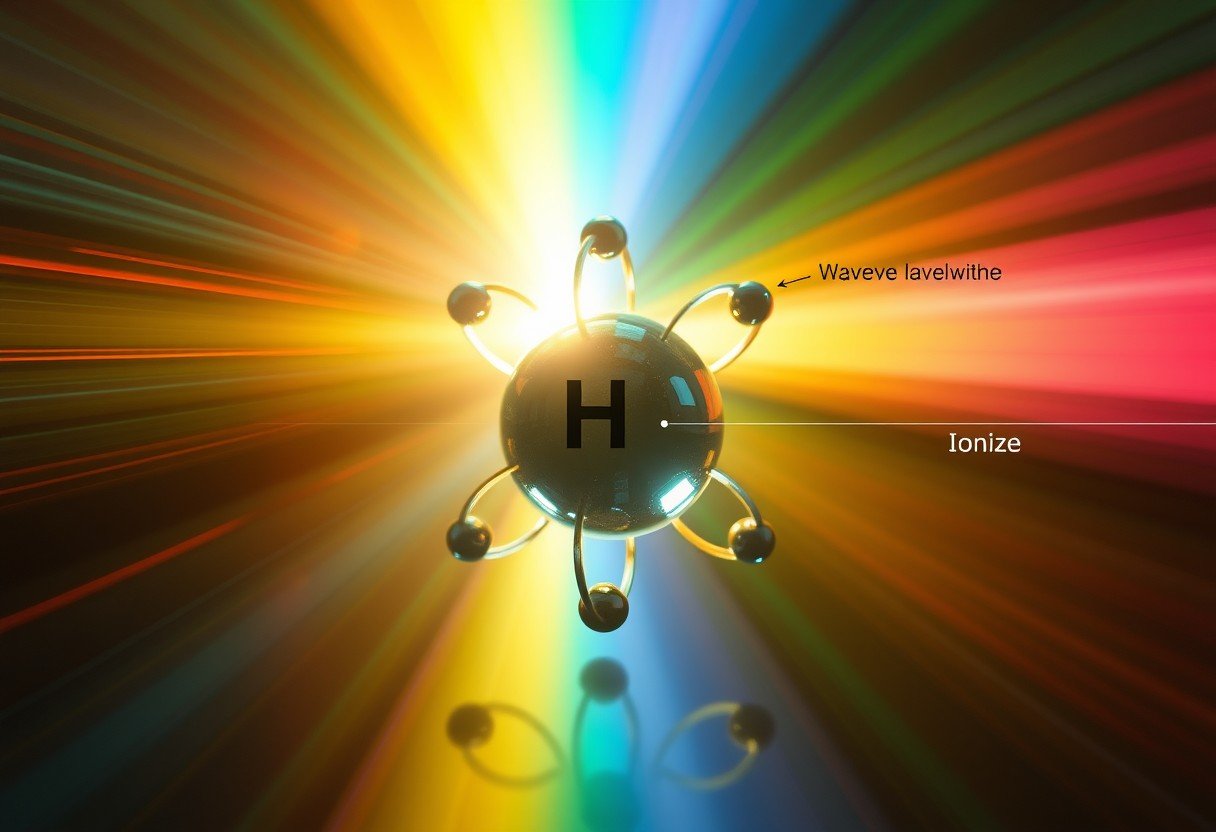Are you curious about how light can strip an electron from a hydrogen atom? The answer lies in the energy carried by a single photon and the corresponding wavelength required for ionization. In this article, we’ll explore what energy and wavelength are necessary, the science behind it, and why it matters in both research and technology.
The Hydrogen Atom and Its Ionization Threshold
Hydrogen is the simplest atom, made up of just one proton and one electron. Despite its simplicity, it plays a crucial role in understanding atomic physics. The energy required to remove its electron is called the ionization energy. For hydrogen, this value is specific: 13.6 electron volts (eV).
This amount of energy means a photon must carry at least 13.6 eV to free the electron. If the energy is less, no matter how many photons hit the atom, the electron remains bound. This unique threshold makes hydrogen a standard reference for ionization studies and helps scientists understand more complex atoms.
Here are key facts about hydrogen’s ionization:
- Ionization energy is exactly 13.6 eV.
- Only a photon with energy equal to or above this can ionize hydrogen.
- This energy level sets the stage for deeper studies in quantum mechanics and astrophysics.
The Science of Photon Energy and Wavelength
Photons, the basic units of light, each carry a specific amount of energy. This energy depends entirely on the photon’s wavelength. The shorter the wavelength, the higher the energy. The relationship between photon energy and wavelength is governed by the physics equation:
E = hc/λ
Where:
- E = photon energy (in joules or electron volts)
- h = Planck’s constant (6.626 x 10-34 Js)
- c = speed of light (3.00 x 108 m/s)
- λ = wavelength (in meters or nanometers)
This equation shows that high-energy photons have short wavelengths, while low-energy photons have longer wavelengths. To ionize hydrogen, you need photons in the ultraviolet (UV) range, as visible light does not carry enough energy per photon.
For context, ultraviolet light has wavelengths between 100 nm and 400 nm, while visible light ranges from 400 nm to 700 nm. Only the shortest UV wavelengths have the necessary energy to ionize hydrogen atoms.
Calculating the Ionization Wavelength for Hydrogen
To find the wavelength of light that can ionize hydrogen, you can rearrange the photon energy equation to solve for wavelength:
λ = hc/E
By plugging in the values for Planck’s constant, the speed of light, and the ionization energy (converted to joules), you find:
| Value | Constant |
|---|---|
| 6.626 x 10-34 Js | Planck’s constant (h) |
| 3.00 x 108 m/s | Speed of light (c) |
| 13.6 eV = 2.18 x 10-18 J | Ionization energy (E) |
Doing the math gives you a wavelength of about 91.2 nanometers (nm). This is in the extreme ultraviolet range. Any photon with a wavelength shorter than 91.2 nm has enough energy to ionize a hydrogen atom. Photons with longer wavelengths (lower energies) cannot do this, regardless of their number.
This calculation is vital in physics and chemistry. It also explains why hydrogen in space can be ionized by strong ultraviolet sources, like young stars or quasars.
Experimental Methods for Measuring Ionization
Scientists use several methods to determine the ionization energy and the related wavelength for hydrogen. Techniques such as photoelectron spectroscopy and mass spectrometry are common. These methods allow researchers to measure the exact energy needed to remove an electron from hydrogen.
In photoelectron spectroscopy, a beam of light is directed at hydrogen atoms. When the right wavelength is used, electrons are ejected and detected. By measuring the energy of these electrons, the ionization threshold can be precisely determined.
Some experimental techniques include:
- Time-of-flight mass spectrometry
- Electron spectroscopy
- Photodetachment studies
Each method offers a unique way to confirm theoretical predictions. Over time, these experiments have consistently shown that the ionization energy for hydrogen is 13.6 eV, corresponding to approximately 91.2 nm.
Applications and Broader Implications
Understanding the wavelength required to ionize hydrogen has far-reaching implications. In astrophysics, knowing this threshold helps scientists explain the behavior of hydrogen clouds in galaxies and the formation of stars. Hydrogen ionization is a key process in the early universe and plays a role in the emission spectra of stars.
In technology, ionizing radiation is used in medicine, security, and nuclear power. For example, extreme ultraviolet (EUV) light is used in advanced semiconductor manufacturing. In medicine, ionizing radiation is crucial for X-ray imaging and cancer treatment.
Key applications include:
- Explaining the emission lines in astronomical spectra
- Understanding the chemical composition of stars and nebulae
- Using EUV light in nanotechnology and lithography
This knowledge bridges fundamental science and real-world technology, showing how a simple atom like hydrogen can be at the heart of major scientific advances.
Summary
To ionize a hydrogen atom, a photon must have an energy of at least 13.6 eV, which corresponds to a wavelength of approximately 91.2 nm in the ultraviolet range. Photons with shorter wavelengths have even more energy and can also cause ionization, while longer wavelengths cannot. This concept is essential in physics, chemistry, and many cutting-edge technologies.
FAQ
What is the minimum wavelength of light that can ionize a hydrogen atom?
The minimum wavelength is about 91.2 nanometers, which falls in the extreme ultraviolet region. Any photon with a shorter wavelength will have enough energy to remove the electron from a hydrogen atom.
Why can’t visible light ionize hydrogen?
Visible light photons do not carry enough energy per photon to reach the ionization threshold of hydrogen. Only ultraviolet photons with wavelengths shorter than 91.2 nm can provide the necessary energy.
How is the ionization energy of hydrogen measured?
Ionization energy is measured using techniques like photoelectron spectroscopy and mass spectrometry. These methods allow scientists to directly observe the energy needed to free an electron from hydrogen atoms.
What happens if a photon with more than 13.6 eV hits a hydrogen atom?
If the photon has more than 13.6 eV, the extra energy is transferred to the liberated electron as kinetic energy. The electron leaves the atom with a higher speed.
How does the ionization of hydrogen affect astronomy?
Hydrogen ionization explains key phenomena in space, such as the emission lines from stars and nebulae. It also helps astronomers study the life cycles of stars and the composition of different cosmic objects.








Leave a Comment